The situation around the personal digital assistant and handheld computers is of undoubted interest. Events in this market is developing very rapidly, and competition was conducted at times even too tough. And it all began, oddly enough now sounds in the distant 80's. Then the British company Psion Computing worked to develop the world's first operating system specifically designed for small handheld computers and mobile devices. Then, in 1984, it was released a device that has received a plain name Organiser 1. This, in essence, an electronic organizer looks very much like an ordinary calculator. Nevertheless, it can be considered the ancestor of all modern PDAs.
 |
 |
Following his first creation company Psion continues to develop the idea of handheld devices equipped with small-size keyboard, and creating new models of its mini-devices: Organiser II, HC and WorkAbout. A bit later, in 1991, Psion released his first mini-computer keyboard Psion Series 3, which became the ancestor of all modern keyboard handhelds. Subsequently, for such devices well established name of the handheld-computing.
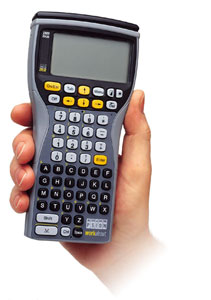 |
And only a year later, in May 1992, Apple CEO John Sculley (John Sculley) presented to the public a prototype device which, according to Apple, should have been thus electronic assistant, accompanying a person in any place and at any time. Called baby Apple Newton NotePad, later renamed the more sonorous Newton MessagePad. Birthday was furnished with a grand sweep and hype. And now, few will remember that the first company that submitted the Pocket PC, it was Psion. Nevertheless MessagePad - the unit by opening a new page in the history of computer technology. Apple has gone the other way, different from the one on which to develop products Psion. Little Newton actually was the first handheld computer, devoid of the keyboard, but has a touch screen. And in this sense for Apple remains the undisputed championship in besklaviaturny devices. In fairness it should be noted that this was a real breakthrough in the new era - an era in which Apple felt like a leader. Newton was out of competition. It just has not been ... At August's Macworld Expo in 1993, the first five thousand units were completely sold at a price of $ 800 in just a few hours.
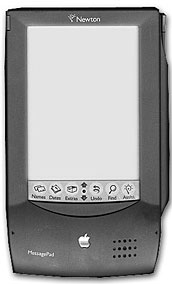 |
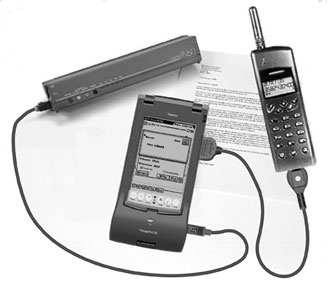 |
In February 1994, Apple introduced a new modification of Newton MessagePad 110. It was a completely revised model, which took into account all the shortcomings of its predecessor. With an interval of one year, the company launches two new versions of the device - MessagePad 120 and MessagePad 130, having twice as large amounts of memory.After some time, comes a new MessagePad 2000, equipped with more advanced StrongARM processor from Intel. In late 1997, Apple launches improved Newton MessagePad 2100. RAM capacity increased four-fold, there was an infrared port and the ability to connect to the network. And while all the time promoting a series of handheld computers Newton this project several times was on the verge of closing the case, the company was good ... But on Feb. 27, 1998 Apple makes an official statement: The company stops all software and hardware design of the project Newton, no new products for this platform will not be released ... This statement just as the snow had fallen on his head. The project was completely collapsed, but Newton has given a powerful impetus to the development of an entire industry of personal mini-computers. At the same time, in the mid-90's, the arena goes company Palm Computing, a developer's own operating system Palm OS. In September 1995 the company Palm Computing was acquired by US Robotics and already in March 1996 began producing the first models of electronic organizers PalmPilot PalmPilot 1000 and 5000, running Palm OS. Models have memory capacity of 128 and 512 KB respectively. In March 1997, there is a new series of PalmPilot, consisting of models Personal (with backlight screen) and Professional (for further development line which supports TCP / IP and increased to 1 MB RAM). In May of that year, now, 3Com buys US Robotics, while buying and Palm. After the conclusion of the transaction all PalmPilot models began to emerge under the trademark of 3Com. Since December 1997, the company began licensing its Palm Palm OS, which allowed further companies such as Nokia, Sony and others, release their products based on this operating system. Exactly one year after the upgrade line PalmPilot, just after the unexpected termination by Apple of all work on the project Newton, in March 1998, Palm is the third generation of its organizers PalmPilot - series Palm III. New models have been 2 MB of RAM and were equipped with an infrared port for exchanging information with other devices.
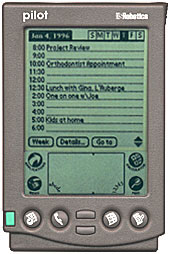 |
The situation in the industry of personal organizers and handheld computers evolved quite successfully. Sales of these devices is steadily growing. The devices themselves are constantly upgraded and is becoming more functionality, portability, reliability and ease of use. For by Palm remained the business besklaviaturny handheld computers. The firm also produced Psion mobile devices equipped with small-size keyboards. All were satisfied and happy ... But this situation has not satisfied another major player - the company Microsoft. In September 1998, Microsoft introduced the first version of its "mobile" operating system Windows CE. However, versions 1.0 and 2.0 of the OS, not yet made any significant contribution to the development of the market for a very simple reason: they both could not stand any competition with a very simple and intuitive operating system Palm OS. A market situation in the meantime has changed so rapidly that sometimes it seemed, even the companies themselves did not have time to watch everything going on. In July 1998, the founders of the company's Palm Computing - PalmPilot developer Jeff Hawkins (Jeff Hawkins), a former president and CEO Donna Dubinsky (Donna Dubinsky) and former vice president of marketing Ed Colligan (Ed Colligan) - left 3Com (Palm Computing to time was owned by 3Com) and created a company Handspring. In early October, the exhibition Internet World'99 new company introduced its first model based on the Palm OS - Visor. During 2000, the company has established sales of its handheld devices worldwide, and also introduced new versions of the series Visor - Solo, Deluxe, Platinum and Prism. To date, the model Handspring Visor Platinum is the most productive handheld computer in the world among the models running Palm OS.
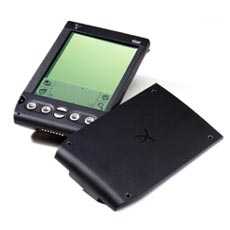 |
At the end of 1999 the number of companies that manufacture products based on Palm OS, joined Founded in 1991, the firm TRG, performed up to this point only the design work for large manufacturing companies. Now her newly created division of TRG Products took over production of the model TRGpro, which is now firmly holds the lead among personal digital assistants.
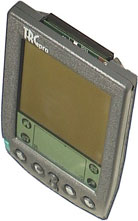 |
However, this story would be incomplete without mentioning the events of June 2000, when Microsoft released the third version of its OS - Windows CE 3.0. She received her happier than their predecessors, but Microsoft would not be itself if it had not come up with another cunning marketing campaigns. Firstly, for handheld computers based on the new OS version 3.0 have been proposed terms for Pocket PC, or more detailed - Microsoft Windows Powered Pocket PC. Secondly, for the operating system the company introduced a new name - Microsoft Pocket PC Windows CE. All this was apparently done with a single purpose - to get rid of the associations with the brand Palm. Did the company such steps? Let's see what will be the conclusions of this review.
 |
And the last. In August this year at the conference Herring on Hollywood world famous top model Claudia Schiffer (Claudia Schiffer) today announced a special version of the Palm Vx Claudia Schiffer Edition. That's really, truly a "secret weapon". Sources, Materials:

















